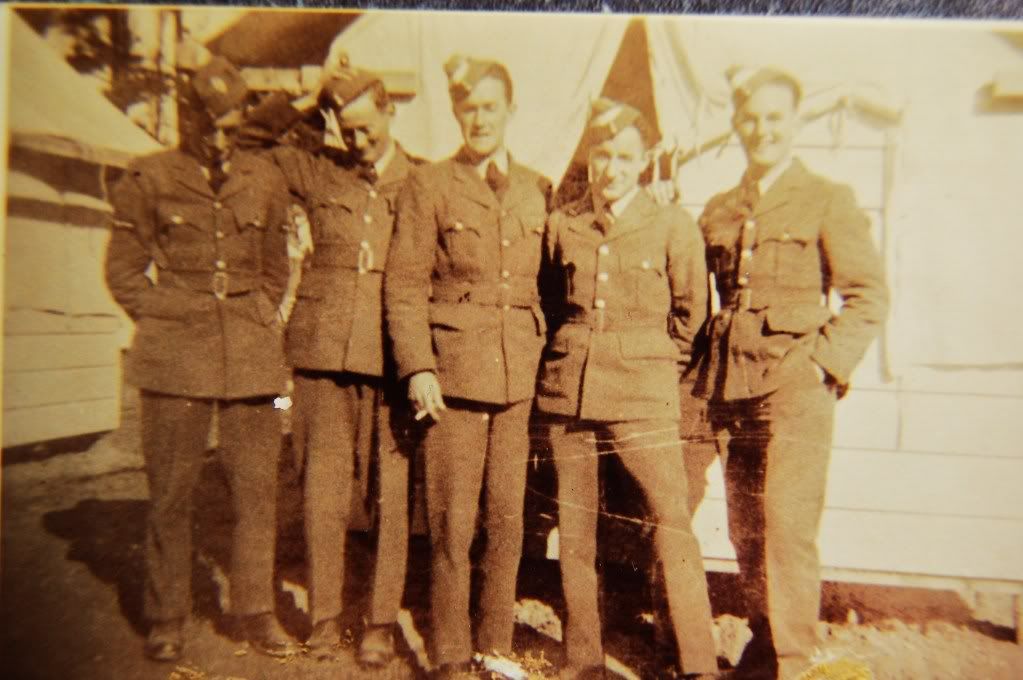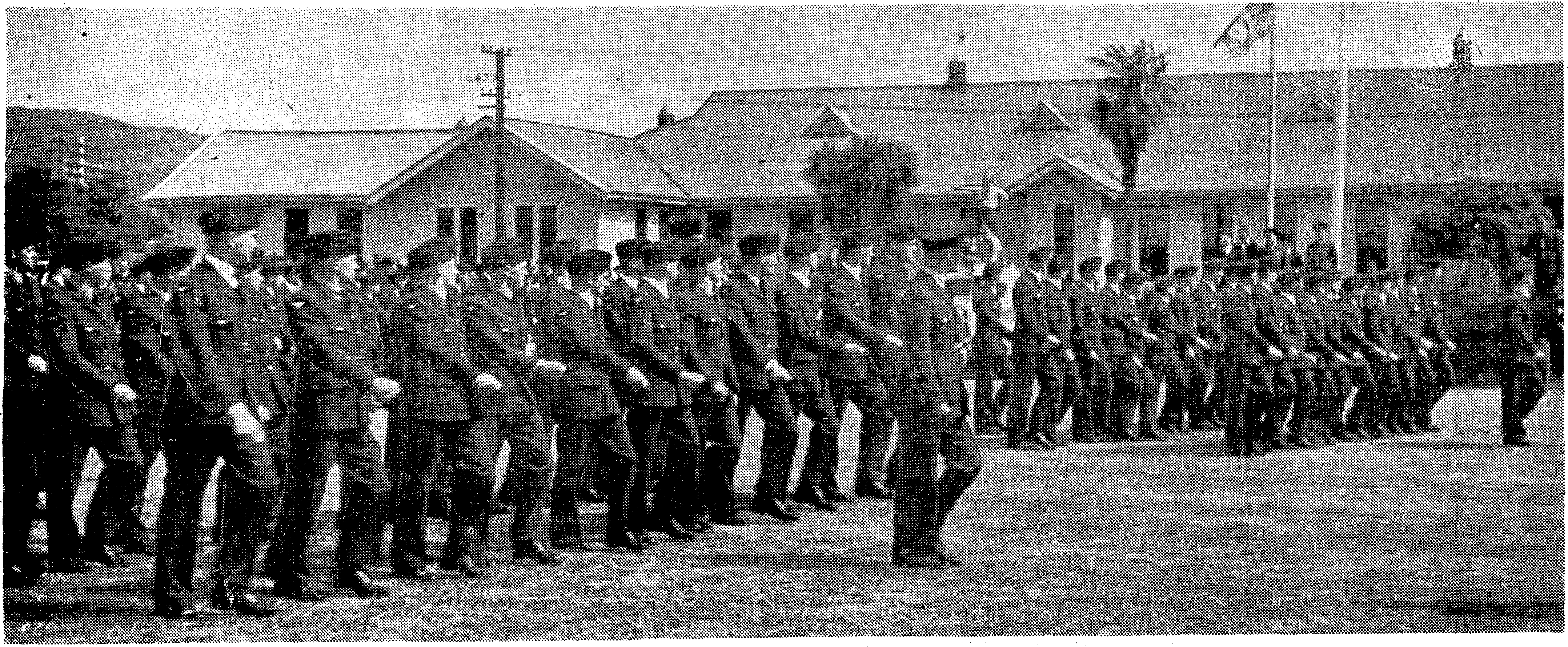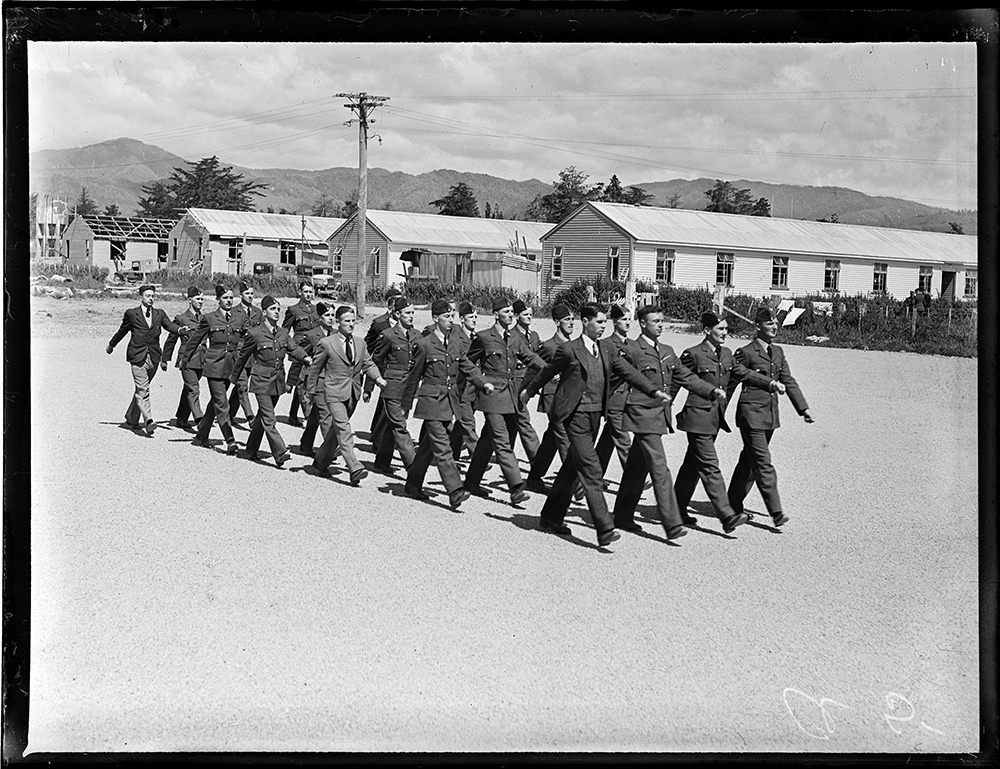|
|
Post by Dave Homewood on Apr 26, 2016 19:03:42 GMT 12
 Mates under training course 19 Pilots July 1941 L to R, John Buckley, Pere Morgan, Johnny Rothwell, ? Roseman, Bill Simpson All flew with RAF Bomber Command, Pere Morgan being killed in January 1945 I am wondering if the chap Roseman above might be F/Lt Noel Eric Roseman pff, RNZAF, who served with W/C Bill Simpson in No. 109 Squadron later? |
|
|
|
Post by pjw4118 on Apr 27, 2016 11:46:53 GMT 12
Yes he was Dave and is in the photo of all ( but Keith Boles ) Kiwi pilots with 109 sq.Bill was close mates with John Buckley until they both passed away a few years ago. John flew with 627 sq until he got himself posted away . Details of them are in Kiwis Do Fly
|
|
|
|
Post by thomarse on Apr 27, 2016 12:29:38 GMT 12
Dave I think we are talking about different sites. When I did a search a few years ago the map I had showed a Boys Correctional Farm on the other side of SH1 in CD Farm Road with a landing strip close by. There still are institutional looking buildings there today. From a 40 year old newspaper cutting , they list 1929 Chichester flights Tararua Rd 1931 Southern Cross flights CD Farm Rd 1933 Levin Aero Club South side Tararua Rd 1940 Kimberley Air Station Little flying many dummy planes 1948 Aero Club reforms at the "old " airfield in Tararua Rd From todays maps Tararua Rd is one block closer to Levin than Kimberley so the airfield presumably ran between the two. The only other thing is that CD probably stands for Childrens Correctional ( Borstal ) I too am interested in this, and the history of Levin is surprising quiet on the subject. The Weraroa strip was AFAIK and as pjw4118 states West of SH1 in CD Farm Road. However, the Air Force Base was clearly called "Weraroa" but I think it was at Kimberley, a couple of miles to the Southeast. From what I've seen, it appears to me that the strip ran between Kimberley and Tararua Roads and was roughly North-South i.e.at right-angles to the prevailing wind, which I find unusual. I can state for absolute sure that the last effort over there was called "Levin/Tararua' and ran East-West - I flew out of it quite a lot in 1967/68. It was located one paddock in from Tararua Road on the Southern side and at one stage in the early 60s there was a small shed in which was housed Horowhenua Earthworks' (Bill Crighton)Rearwin AKF |
|
|
|
Post by Dave Homewood on Apr 27, 2016 18:04:12 GMT 12
Yes he was Dave and is in the photo of all ( but Keith Boles ) Kiwi pilots with 109 sq.Bill was close mates with John Buckley until they both passed away a few years ago. John flew with 627 sq until he got himself posted away . Details of them are in Kiwis Do Fly Yeah it was your book and other research that led me back here and then I spotted Roseman and thought it had to be the same man. Also missing from that No. 109 Squadron photo was Alan Dray DFC pff. He was from here in Leamington, Cambridge. |
|
|
|
Post by pjw4118 on Jan 13, 2017 15:49:47 GMT 12
Over Xmas I spent a bit of time in Levin looking for more details about Weraroa.
Originally the CD ( Central Development )Farm road area and Kimberley Rd ( RNZAF ) were both part of an 800 acre Government owned block , munch of which remained State owned until the late 1980s. Originally an experimental farm the Wereroa part became Levin State Farm for " unemployed elderly men. " and reformatory school for boys. In 1918 it also held religious conscientious objectors.
In 1939 the Kimberly Road site was commandeered by the RNZAF and the borstal moved across to CD Road over a weekend.
Things happened quickly in those days , a request to the PWD to provide a satellite airfield for Ohakea at Weraroa was made on 1/7/41 and the airfield opened a month later. As well as an ITW , ground radar operators were trained there and although uniformed as RNZAF or WAAFs they did not come under Air Force control.
Post war the borstal remained in CD road and was extended , having its own cell block built in 1966.The borstal closed in 1989 and today the site remains mainly empty but perhaps with Waitangi obligations. It is classified as Historic Cat 1.
Three movies were made at the site and named Kohitiri , they are available on NZ on Air Film .
I will post a couple of photos of the CD road remains.
|
|
|
|
Post by pjw4118 on Jan 14, 2017 19:35:46 GMT 12
|
|
dgsg
Flight Sergeant

Posts: 21
|
Post by dgsg on Feb 15, 2017 13:58:41 GMT 12
The site of the old Kimberley Hospital is now being developed into a retirement village, so eventually any WWII vintage buildings still on the site will probably disappear. They're keeping/renovating the chapel apparently, but I don't know if that's WWII or post-war.
|
|
|
|
Post by Dave Homewood on Jul 1, 2017 19:12:53 GMT 12
Some early newspaper photos: From the Evening Post, 20th of November 1939   From the Evening Post, 22nd of November 1939   From the New Zealand Herald 23rd of November 1939   |
|
|
|
Post by Dave Homewood on Jul 1, 2017 23:06:33 GMT 12
|
|
|
|
Post by Bruce on Jul 2, 2017 9:10:40 GMT 12
From the EVENING POST, 18 DECEMBER 1939   From the EVENING POST, 19 DECEMBER 1939   Obviously they didnt have enough classrooms! (I'm sure these shots were posed for the photographer for better effect, like the briefing scene in "Top Gun"...) |
|
|
|
Post by Dave Homewood on Jul 2, 2017 10:36:29 GMT 12
Maybe Bruce, but I do recall we had a lot of outdoor lectures on our Basic Training course at GSTS, Woodbourne, in 1989 too. I can see merit in outdoor lectures for some things, like the compass bearing training, parachute training (they usually popped one and infated it in the wind to demonstrate its parts), etc.
|
|
|
|
Post by Dave Homewood on Jul 2, 2017 19:56:46 GMT 12
From the EVENING POST, 13 APRIL 1940   |
|
|
|
Post by Dave Homewood on Sept 6, 2017 19:31:51 GMT 12
 Weraroa Flying School New Zealand Herald Nash, P F Date - November 1939 |
|
|
|
Post by Dave Homewood on Nov 10, 2017 22:45:19 GMT 12
 Date: 1932 - 1948 Ref: Plans-2012-011-016 Broad plan view of the RNZAF GTS (Ground Training School), showing the Headquarters, lecture room and officers' mess areas, as well as a circular rose garden with a reflection pool, and a tennis court and swimming pool. In addition to these details, the plan shows the position of two other tennis courts, the sick quarters, sergeants' and airmen's mess halls, a further lecture block, equipment store, garage and car wash, and parade grounds. Incorporates more rose gardens and a tree-lined driveway From the National Library hereFor a larger version you can zoom in on, go here |
|
|
|
Post by Dave Homewood on Jun 7, 2018 15:04:59 GMT 12
Here's an article from the WAIKATO INDEPENDENT, dated 22 NOVEMBER 1940:
IN AIR FORCE BLUE
TRAINING THE FLIERS
INTAKE STATION AT WERAROA
The Kiwi of the air stations — it possesses no "wings' — Weraroa is the Royal New Zealand Air Force's "intake" point for all pilots, observers and air gunners. It is the place where the men who will have wings are grounded in the first steps of their training.
For this preliminary course the Air Force took over from the Education Department one of its training institutions, a mile or so outside Levin, equipped with well-planned gardens, plenty of green sward and good permanent buildings. For additional accommodation new dormitories and streets of boarded tents have been spread over the adjoining paddocks.
Immediately on arrival the recruit makes a complete break with the old life by packing up his "civvies" and donning the Air Force blue uniform. In an article Charles E. Wheeler gives the initial issue to the recruit, the complete total of his official possessions: one greatcoat, two complete uniforms, two pairs socks, two pairs boots, two shirts and four collars, clothes-brush, button-brush and stick, tie, gym. vest, canvas gym. shoes, two caps and badges, five blankets (more can be obtained at choice), one pair of sheets and a pillow slip (regularly replaced as they require washing).
At first parades of new recruits, uniforms are closely scrutinised, suggestions for improvement noted, and a visit to the camp tailor eventually produces a smart fit.
Much Study Required
"Training makes you one step better than the enemy," is the axiom learned at the first lecture. There is so much study in the Air Force that the men are relieved of most fatigues. The course is intensive. Men must keep their uniforms clean, and modern facilities including a drying-room are available for their personal washing. But there are no cook-house fatigues, nor is the recruit required to clean up the camp grounds — he has quite enough to do with his studies, varied by some early morning physical exercises, and breaks between lectures.
Most of the young men get to bed by 9 p.m. Every man has a wardrobe, and sleeps on a spring mattress. He must be tidy. In the morning bed clothes have to be folded into a neat pile like a sandwich at the end of the stretcher.
The men come to mess with their own cups and cutlery; they line up to be served, and find the tables laid for the rest. Diet is planned to include raw and cooked fruit, and fresh vegetables such as lettuce. The men are represented on a messing committee, where with the camp officers including the doctor, the dietary scale is decided periodically.
Service Friendship Developed
Recruits are immediately formed into flights of a convenient number for lectures, possibly 30 in a group. They go through the course together, and are sent as a flight to their next station. They elect two of their number to exercise control, marching them to meals and making sure that every member of the flight attends lectures. This system assists in their development of friendships and builds a disciplined body with some idea of Air Force traditions and obligations. The course for pilots is six weeks, for observers two months, and for gunners about a month.
Most of the air gunners and observers go straight to Canada, under the Empire air training scheme. The "rough spots" have been knocked off. They then know a good deal about the guns used on aircraft, understand much of the technical side of radio transmission, and have a sound groundwork in navigation. So much has to be taught in this first month that only one week-end leave is given during the whole period.
Powers of Observation Tested
Experienced officers, from knowledge of the young airmen and records of their examinations, can determine what they can best do in the Air Force; that an individual is marked out for a pilot, an observer, or that he will develop into a skilled gunner. The station has many lecture rooms, and a large staff of qualified officers who invite questions and test the attention of the class by occasional discussion.
A generous amount of diagrammatic material is available, which the Home authorities have provided. Some of the subjects are best taught through talkie films, others by long series of good photographs. For instance, the young airmen are shown in this way numberless tell-tale features of the landscape as seen from the air. There are points of importance in the landscape which show up vividly, from a height, and the pupil is taught to interpret them. His general power of observation is tested. An example of this is seen in a photograph of part of a typical English city, with a large church showing in the centre. "At what time of the day, and on what day of the week was this photograph taken?" is asked. The east window of the church provides a clear guide to compass direction, and shadows suggested the answer "3 o'clock in the afternoon." But there is the day of the week to discover. Not till attention is caught by family washing hanging from many lines in back gardens does one realise the answer must be Monday,
"What makes a good soldier or an airman?" recruits are asked in an introductory address by the station commander, Squadron Leader R. J. Sinclair, on their first day- in uniform. He tells them that the answer is: Patriotism and esprit de corps. Discipline. Physical fitness —clean living. Technical skill,
"Your training," he adds, "is aimed at bringing out all these attributes."
|
|
|
|
Post by Dave Homewood on Jun 7, 2018 15:08:18 GMT 12
Articles like the above make me realise the RNZAF recruit training in the 1940's was so similar to when I went through in 1989, it shows they knew what they were doing, they found the best method and stuck to it. Not like the civilian education system.
I also learned a new word fro that article, "sward" - an open expanse of short grass.
|
|
|
|
Post by Dave Homewood on Aug 20, 2018 21:16:17 GMT 12
I just happened upon this snippet from the WAIKATO INDEPENDENT, dated 31 AUGUST 1945
Farm Colony at Levin.
The property at Levin which used to be the Weraroa Boys’ Training Farm, but was an Air Force training station for several years during the war, is now being used by the Mental Hospitals Department for the accommodation of children in the same class as those at Templeton farm colony, near Christchurch. The existence of such an institution in the North Island will enable children who require to live in one to be nearer their homes, if their homes are in the North Island, than they would be at Templeton. The patients which the department has at Templeton and intends to have at Levin are children who are mentally deficient but not insane, including some who are adult in years but have remained childish mentally. They require protection from the hazards of normal life, but live and work satisfactorily in an institution.
|
|
|
|
Post by Dave Homewood on Sept 4, 2018 22:51:46 GMT 12
This map comes from the National Library's collection.  Ref: Plans-2012-011-016 Broad plan view of the RNZAF GTS (Ground Training School), showing the Headquarters, lecture room and officers' mess areas, as well as a circular rose garden with a reflection pool, and a tennis court and swimming pool. In addition to these details, the plan shows the position of two other tennis courts, the sick quarters, sergeants' and airmen's mess halls, a further lecture block, equipment store, garage and car wash, and parade grounds. Incorporates more rose gardens and a tree-lined driveway Inscriptions: Recto - bottom right: Trevor S Buxton NDHNZ / Landscape Architect / Palmerston North [partially obscured] Page link hereFor a larger version where you can read all the words click here |
|
kwest
Leading Aircraftman

Posts: 2
|
Post by kwest on Dec 20, 2018 10:41:26 GMT 12
Hi,
I only just found out that the property next door (ie RNZAF Wereroa) was a WW2 ground training unit from speaking with the previous owner! I then did a bit of digging and it brought me here. Fascinating stuff, I’m a bit of a military history junkie as being a serving member of the NZDF (and ex RN) such info is of great personal interest. I’m going to collate maps and aerial photos to make a display for the wall of the man cave as with the redevelopment of the site much of the remaining fabric and infrastructure will likely be lost.
|
|
|
|
Post by pjw4118 on Dec 21, 2018 8:16:09 GMT 12
If I were you , get over the fence and collect any items of interest , as I am sure that there are a few boards with carefully carved names in some of the old dorms/classrooms !
|
|



